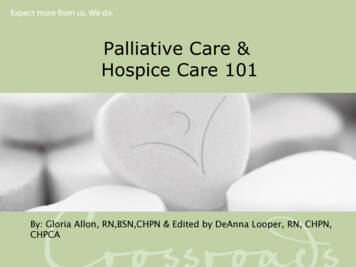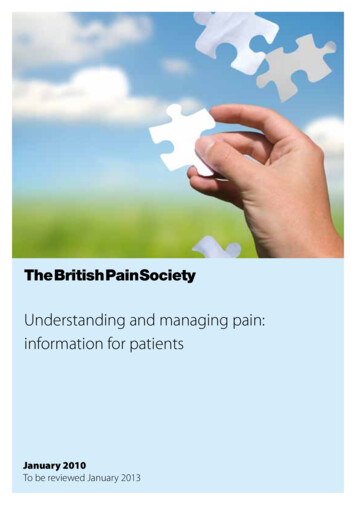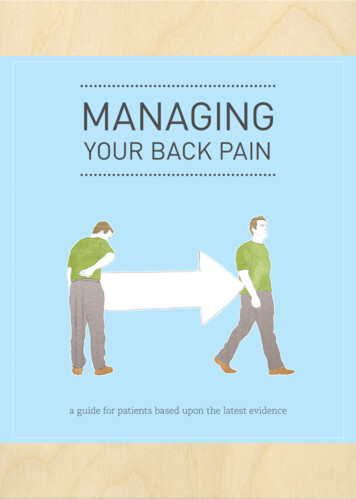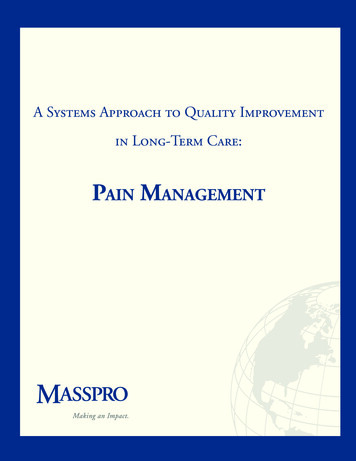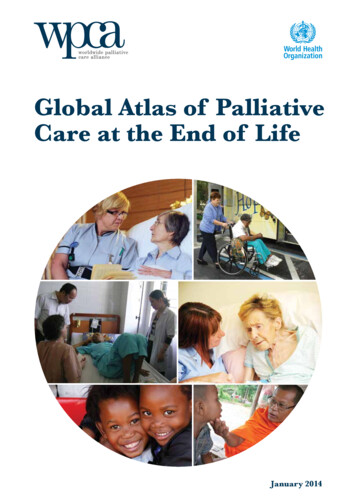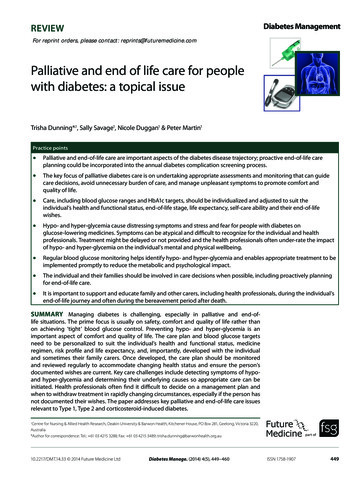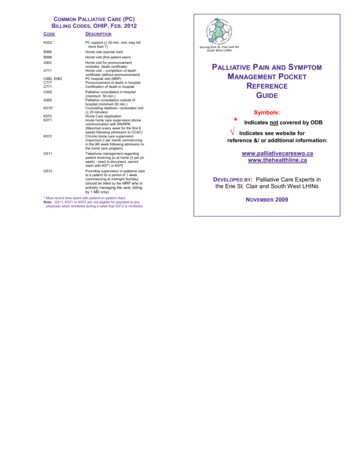
Transcription
COMMON PALLIATIVE CARE (PC)BILLING CODES, OHIP, FEB. 2012CODEDESCRIPTIONK023 *PC support ( 20-min. visit, may billmore than 1)B966Home visit (special visit)B998Home visit (first patient seen)A902Home visit for pronouncement(includes death certificate)Home visit – completion of deathcertificate (without pronouncement)PC hospital visit (MRP)Pronouncement of death in hospitalCertification of death in hospitalA771C882, E083C777C771C945A945K015*K070K071K072Palliative consultation in hospital(minimum 50 min.)Palliative consultation outside ofhospital (minimum 50 min.)Counseling relatives—scheduled visit( 20 minutes)Home Care ApplicationAcute home care supervision phonecommunication with RN/RPN(Maximum every week for the first 8weeks following admission to CCAC)Chronic home care supervision(maximum 2 per month commencingin the 9th week following admission tothe home care program)G511Telephone management regardingpatient receiving pc at home (2 per pt/week) - need to document, cannotclaim with K071 or K072G512Providing supervision of palliative careto a patient for a period of 1 week(commencing at midnight Sunday)(should be billed by the MRP who isactively managing the care; billingby 1 MD only)* Must record time spent with patient on patient chart.Note: G511, K071 or K072 are not eligible for payment to anyphysician when rendered during a week that G512 is rendered.PALLIATIVE PAIN AND SYMPTOMMANAGEMENT POCKETREFERENCEGUIDESymbols:* Indicates not covered by ODB Indicates see website forreference &/ or additional ine.caDEVELOPED BY: Palliative Care Experts inthe Erie St. Clair and South West LHINsNOVEMBER 2009
DISCLAIMERThe “Palliative Pain and Symptom Management Pocket Reference Guide” provides pain and symptom management information; this information is not medical advice. This guide wasdeveloped as general information for physicians and registerednurses with palliative care expertise only; physicians andnurses should exercise their own independent clinical judgment. To the best of our ability, we have provided referencesfor the information contained within this reference guide.Where references are not available, the information reflectslocal practice by Palliative Care Expert Physicians in the ErieSt. Clair and South West Local Health Integration Networks(LHINs). Health care providers must be fully informed beforeprescribing any products and while we endeavour to keep theinformation up to date and correct, we make no representationor warranties of any kind, express or implied about the completeness, accuracy, reliability or suitability with respect to theinformation or products.In no event will we be liable for any loss or damages includingwithout limitation, indirect or consequential loss or damage orany loss or damage whatsoever arising from or out of the useof this reference guide.Note: many references for the PALLIATIVE PAIN & SYMPTOMMANAGEMENT POCKET REFERENCE GUIDE originate with ThePallium Palliative Pocket Book 2008. To purchase this manualvisit areswo.cawww.thehealthline.caPalliative Pain and SymptomManagement ConsultationProgram, Southwestern Ontario.St. Joseph’s Health Care,London, Ontario, Canada.November 2009COMMITTEE MEMBERSDr. Glen Maddison, Chair November 2009 to PresentDr. Ingrid Harle, Chair 2007- October 2009WINDSOR AND ESSEX COUNTYSharon Allen, NP, M.SC.N., CHPCN(C)Angie Deneweth, NPJanet Elder, Reg.N, CHPCN(c)Jim Gall, MDCarole Gill, Reg.N., CHPCN(C)Karen Riley, BSCPhm, Pharm D, BCPS, RPhKENT AND LAMBTON COUNTIESAnn Brignell, Reg.N., CHPCN(C)Glen Maddison, MDELGIN AND OXFORD COUNTIESBrian Fathers, BSC Pharm, R PharmacistIda Tigchelaar, Reg.N., CHPCN(C)LONDON AND MIDDLESEX COUNTYSharon Baker, MDIngrid Harle, MD, FRCSC, CCFP, FCFP, ABHPMNancy Keat, Reg.N., B.SC.N., M.SC., CHPCN(C)HURON AND PERTH COUNTIESJudy White, Reg.N., CHPCN(C)GREY AND BRUCE COUNTIESHilli Huff, MD, CCFPLiz Laird, Reg.N., BSCN, CHPCN(C)Marie Palmer, Reg.N., B.A., CHPCN(C)2020
NOTESINDEXPAIN MANAGEMENTPain Management Steps . 1Opioid Dosage . 1Titration of Opioids . 1Opioid Toxicity . 2Opioid Rotation . 3Equianalgesic Dose . 3Fentanyl Patch . 4Analgesics to Avoid . 4Opioid Overdose . 5Common Opioid Side Effects . 5Must Know . 5Pseudoaddiction/Tolerance/Dependence . 5Wounds . 6Incident Pain/Procedural Pain . 6Etiology of Pain . 6Adjuvant Interventions . 6SYMPTOM MANAGEMENTG.I Protection . 8Nausea . 8Mouth Care . 9Bowel Routine . 9Malignant Non-operable Bowel Obstruction . 10Malignant Ascites . 10Hiccups . 11Dyspnea . 11Respiratory Secretions . 12Hypercalcemia . 12Excessive Sedation . 12Delirium . 13Depression . 13Acute Seizure Control . 13Myoclonic Jerking . 14Terminal Restlessness . 14Intractable Symptoms at End of Life . 14PPS . 15ESAS . 16Equianalgesic Dosing Chart . 17Common PC Billing Codes, OHIP, April 2008 . back cover1919
PAIN M ANAGEMENTNOTESPAIN MANAGEMENT STEPS screen for pain: ask regularly (i.e., the 5th vital sign, use ESAS )and observe for behaviours indicative of pain assess to determine the etiology of the pain initiate interventions considering the patient’s goals, age, PPS ,pain type, kidney/liver function monitor and document the efficacy of each intervention using apain intensity scale of 0 – 10 assess efficacy of breakthrough doses one hour post oral dose,half hour post SC dose, 5 – 10 minutes post IV dose reassess & revise the plan as necessary until goals are met consult with a palliative care expert when comfort goals are notbeing met OPIOID DOSAGE the appropriate dose of opioid is the amount that manages thepain with the fewest side effects there is no ceiling dose unless using a mixed analgesic such asTylenol with codeine or oxycocet, which contain acetaminophenas well as an opioid; acetaminophen has a total daily intake limitof 2.6 gm (in the elderly or those with organ impairment) to 4.0gm (healthy patient) TITRATION OF OPIOIDS start with q4h around the clock (ATC) dosing with immediaterelease (IR) opioid and titrate to effect or until side effectsbecome unmanageable when titrating, allow the opioid to reach steady state beforeincreasing the regular around the clock (ATC) dose steady state occurs at 4 – 5 times the drug half-life. Halflife depends on the particular opioid and whether it isimmediate release or long acting generally, immediate release opioids can be titrated every 24 hrsand long acting opioids can be titrated every 48 – 60 hrs111818
.PAINM ANAGEMENTTITRATION OF OPIOIDS (CONTINUED) once the steady state has been reached, a new order forthe ATC dose of opioid is calculated based on the TOTALopioid dose administered in the previous 24 hours[TOTAL break through (BT) doses used plus regular ATCdoses in 24 hours]. Use clinical judgment in determining thenew ATC order always order a BT, immediate release dose: whenever possible use the same opioid as is beingadministered on a regular basis calculate approximately 10 % of the TOTAL dailydose of the scheduled ATC opioid and order it prnfor uncontrolled pain (see page 17) the breakthrough dose is calculated in the same wayno matter which route of administration is beingused consider opioid rotation for unmanageable side effects andadjuvant interventions for difficult to manage painthe fentanyl patch (LU 201) is a slow release form of a quickacting medication (fentanyl). Do not titrate to a strongerpatch more rapidly than every 6 days if pain is not managed, increase BT doses, using IRopioids (e.g., morphine, hydromorphone) until it issafe to titrate the patch OPIOID TOXICITY metabolites of morphine and to a lesser extent,hydromorphone must be cleared renally; anyone with renalcompromise (including the elderly) is at increased risk fortoxicity suspect opioid toxicity if increased agitation occurs myoclonus may be an early warning sign of opioid toxicity dehydration may increase risk of toxicity172172
.PAINM ANAGEMENTCONSIDER OPIOID ROTATION IF ONE OF THE FOLLOWING OCCURS decreased renal function (neurotoxic metabolite build upassociated with morphine and hydromorphone) intractable nausea and/or vomiting delirium (hyperactive or hypoactive) myoclonus dysphoria persistent intolerable sedationOPIOID ROTATION (SWITCHING TO ANOTHER OPIOID)When rotating opioids: determine the equianalgesic dose consider decreasing the dose of new drug by 30% toaccount for incomplete cross-tolerance Use breakthrough (BT) doses and titrate to effectEQUIANALGESIC DOSE (APPROXIMATE ONLY)DRUGPOSC OR IVMorphine20 mg10 mgHydromorphone5 mg2 mgOxycodone10 mgNACodeine200 mg120 mg three Tylenol # 3s are approximately equal to morphine 10mg PO plus acetaminophen 900 mg PO two Percocet are approximately equal to morphine 20 mgPO plus acetaminophen 650 mg PO remember incomplete cross-tolerance methadone is used for analgesia. It has unusualpharmacodynamics and pharmacokinetics and multipleinteractions with other drugs . Physicians require anexemption license to prescribe methadone for pain331616
PAIN M ANAGEMENTFENTANYL PATCH do not use for rapidly escalating pain do not use in an opioid naïve person do not cut reservoir patch patches are changed q72h (occasionally q48h); fentanyl doesnot have a short acting oral equivalent for BT pain Starting Fentanyl: starting dose: 60 - 134 mg oral morphine per day isapproximately equal to fentanyl 25 mcg patch q 72h an appropriate BT dose for fentanyl 25 mcg patch would bemorphine 10 mg PO q1h prn or hydromorphone 2 mg PO q1hprn regular dosing of the q4h (IR) oral opioid is continued for 12hours after applying a fentanyl patch the patch can be applied simultaneously with the administrationof the last dose of a long acting (q12h) oral opioid or 12 hoursafter administration of a q24h opioidStopping Fentanyl: fentanyl patch has 12-18 hour half-life commence regular ATC opioid dosing 12 hours after removingthe patch; give BT doses as requiredANALGESICS TO AVOID Fiorinal not for use in palliative care meperidine (Demerol )- neurotoxic metabolite accumulation pentazocine (Talwin ) - agonist-antagonist with severepsychotomimetic effects propoxyphene - increased risk of side effects profile in the elderly151544
SYMPTOM M ANAGEMENTPAIN M ANAGEMENTOPIOID OVERDOSE use sedation scale to determine level of sedation consider the PPS step 1: stimulate the person if sedation is increasing step 2: if sedation is unexpected and the sedation score is 3and respiratory rate is 6/min and this is unexpected,consider judicious use of naloxone. If too much naloxone isgiven, it will precipitate a pain crisis. Starting IV dose: dilutenaloxone 0.4 mg/ml with N/S 9 ml and give 1ml IV q 5-10minutes until respirations 6 and sedation level 3 physician consultation requiredCOMMON OPIOID SIDE EFFECTS constipation: is universal and tolerance does not occur consider osmotic & stimulant laxatives daily, titrate to effect nausea / vomiting: consider CTZ, D-2 antagonist as aprophylactic measure; tolerance may develop sedation : usually temporary. If sedation is persistent,consider opioid rotation or use of methylphenidate. Considerthe PPSMUST KNOW if treatment (e.g., radiation) results in decreased pain, thengradually decrease opioids. Too much opioid may lead tosedation as the pain level decreasesPSEUDOADDICTION / TOLERANCE / DEPENDENCE pseudoaddiction describes behaviours that may be perceivedas drug-seeking but actually only occur when pain is undertreated; the behaviours resolve when pain is effectivelymanaged most patients over time do become physiologically dependenton opioids and will have withdrawal symptoms with abruptdiscontinuation or major dose reduction opioid tolerance and physical dependence arephysiological and do NOT equate with addiction 55MYOCLONIC JERKING (CAN BE DUE TO OPIOID TOXICITY ) consider hydration consider side effects of medications check calcium and creatinine blood levels reduce or rotate opioid lorazepam 1 – 2 mg PO/SL/SC q6h clonazepam 0.5 – 2 mg PO qhs (or 0.5 mg PO q6h prn)TERMINAL RESTLESSNESS eliminate all possible causes (e.g., urinary retention, fecal impaction) consult with person and family regarding intent of interventions haloperidol 1.0 mg – 5.0 mg SC q 6h haloperidol 1.0 mg – 5.0 mg SC q6h plus lorazepam 1 - 4 mgSC/SL q6h (or midazolam* 2.5- 5mg SC q 6h) methotrimeprazine 5 - 50 mg PO/SC od and q4h prn midazolam,* lorazepam (same as dosage for seizures)INTRACTABLE SYMPTOMS AT END OF LIFECriteria for sedation for intractable symptoms : verify that symptoms are intractable; palliative medicine consultation highly recommended patient/family conference with PC team to inform and obtain consent for sedation as sedation precludes communication with patient; and suggest d/c IV/parenteral feeding possible medications that can be used for intractable symptomsat EOL include midazolam, methotrimeprazine, propofol, phenobarbital1414
SYMPTOM M ANAGEMENTPAIN M ANAGEMENTDELIRIUM (CONSIDER ETIOLOGY AND TREAT APPROPRIATELY)Hyperactive, hypoactive (may masquerade as depression) and mixed look for disordered thinking, fluctuating course, altered cognition consider opioid rotation haloperidol 0.5 – 5.0 mg PO/SC q4-6h prn as interim (first line) methotrimeprazine 5 - 50 mg PO/SC q4h prnDEPRESSION consult PC team for emotional, psychosocial support antidepressants (SSRI & SNRI) (consider PPS before initiating) consider concurrent use of SSRI/SNRI with methylphenidate 10 –20 mg PO bid 0800h & noon; suggested maximum 1 mg/kg/day;d/c when SSRI/SNRI effectiveACUTE SEIZURE CONTROL (IF PATIENT IS ACTIVELY SEIZURING ) lorazepam 2 mg Buccally or SC stat and 2 mg Buccally or SC q30min prn until controlled Or midazolam * 5 – 10 mg SC stat and q30 min until controlledOngoing maintenance if / when patient no longer able to swallow: phenobarbital 30 – 240 mg SC q 8-12h (not available in community above 30 mg/ml) midazolam 20 – 60 mg /24h per CSCI carbamazepine supp * 25% increase from oral dose; or 8 – 20 mg/kg/day, bid or qid valproic acid liquid 15 – 60 mg kg/day PR bid or qid diazepam 10-20 mg PR q 15 min prn1313WOUNDS: morphine in intrasite gel for local analgesia INCIDENT PAIN / PROCEDURAL PAIN pre-empt predictably occurring pain by using a prn dose inadvance use a short acting opioid and administer prior to theprocedure or event. Allow 1 hour following POadministration and ½ hour following SC for the opioid toreach peak effect first choice is sufentanil 12.5 -50 mcg SL 15 minutes prior toprocedure; if sufentanil not available may use fentanylinjectable * can be used sublingually for incident orprocedural pain 25-50 mcg SL 30 minutes prior toprocedure consider EMLA topical cream for painful IV startsADJUVANT / CO- ANALGESIC PAIN MANAGEMENTCONSIDERATION OF THE ETIOLOGY OF PAIN IS ESSENTIAL INSELECTECTING THE MOST EFFECTIVE ADJUVANT MEDICATION opioids are first line, then consider appropriate co-analgesic/adjuvant for each pain syndrome (e.g., bone, nerve,inflammatory, intracranial pressure, ischemia, musclespasms)ADJUVANT INTERVENTIONSBone Pain: NSAIDs bisphosphonates corticosteroids radiation consider orthopedic stabilization66
.PAINSYMPTOM M ANAGEMENTM ANAGEMENTADJUVANT INTERVENTIONS (CONTINUED)Neuropathic Pain: radiation of tumour to relieve tumour pressure TCA and/or anti-convulsant meds; common drugs used are: nortriptyline, amitriptyline carbamazepine, valproic acid gabapentin * : for starting dose and titrationguidelines Pregabalin * : indicated for diabetic peripheralneuropathy and postherpetic neuralgia consult anesthesia or interventional radiology for nerveblock methadone is an excellent drug but requires a methadoneexemption license for pain management; consult with apalliative care physicianLiver Capsule Pain: corticosteroidsTumour expanding in a small space: corticosteroids radiationSEVERE PROGRESSIVE DYSPNEA consult with a Palliative Medicine Expert protocol for sedation for intractable symptoms at the end of lifemay be required RESPIRATORY SECRETIONS atropine 1% ophthalmic 3 gtts SL/Buccal Space q1-2h prn glycopyrrolate * 0.2 – 0.4 mg SC (each ml 0.2 mg) q4h (nonsedating as does not cross blood-brain barrier) hyoscine hydrobromide * 0.4 mg SC q3h(also available as Transderm V patch * q 3 days – paranoia andconfusion may develop in elderly patients) consider repositioning suctioning is not usually indicatedHYPERCALCEMIA (CORRECTED VALUE OVER 2.65 MMOL )To calculate corrected calcium level total serum calcium level [(40 minus serum albumin level) x .02]OR to correct, add 0.02 mmol for every gm albumin below normal Inflammatory Pain: NSAIDs corticosteroids hydrate with normal salinepamidronate 60 – 90 mg IV in 500 ml normal saline over 4 hours,q3-4 weeks – wait 72 hours post infusion to recheck levelszoledronic acid * 4 mg in 50 cc normal saline IV over 15 minutesq 3- 4 weeksEXCESSIVE SEDATION assess analgesic and reduce if possible consider opioid rotation methylphenidate 2.5 - 15 mg PO 0800 h & 12 noon (start low &titrate to maximum effect 30-60 mg od); may also improve cognitive function, activity (consider PPS, prior to initiation)Raised Intracranial Pressure: (from intracranial tumours) corticosteroid radiation, neurosurgeryMuscle Spasms: benzodiazepine baclofen771212
SYMPTOM M ANAGEMENTSYMPTOM M ANAGEMENTHICCUPS (NOTE–CHLORPROMAZINE CAUSES ORTHOSTATICHYPOTENSION ) haloperidol 1 – 2.5 PO/ SC q4h prn metoclopramide 10 – 20 mg SC */PO qid baclofen 10 – 20 mg PO q4h prn methotrimeprazine 12.5 – 25 mg PO/SC q6h prn chlorpromazine 12.5 – 50 mg PO/IV q4h prnG.I. PROTECTION H2 antagonist (e.g., ranitidine 150 mg PO bid)cytoprotector (e.g., misoprostol 200 mg PO tid – qid)proton pump inhibitor (PPI), (e.g., rabeprazole 20 mg PO od)NAUSEA (CONSIDER ETIOLOGY)Prokinetics (may be contraindicated in complete bowel obstruction): metoclopramide (10 – 20 mg PO/ SC */ IV * q 4h – 6h) domperidone 10 – 20 mg PO qidDYSPNEAFirst Line: fan (air movement) oxygen for ODB criteria positioning of patient for ease of breathing & comfort emotional support and safety physiotherapyCTZ, D2 Receptor or Antagonist: haloperidol 0.5 – 2.5 mg PO/ SC bid – tidSteroid: dexamethasone 2 – 8 mg PO/ SC/ IV odSecond Line: recent studies have indicated that the use of systemic opioid ismore effective than nebulized opioid if opioid naÏve, start with low dose, short acting opioid q4h fordyspnea control (e.g., morphine 2.5 - 5 mg PO q4h) if on long acting opioid for pain, increase the baseline by 30%for dyspnea control and adjust breakthrough dose use the adjusted breakthrough opioid dose for pain or dyspnea titrate opioid using pain management principles Other measures to consider based on etiology of dyspnea: nebulized normal saline q4 - 6h nebulized salbutamol and ipratropium (LU #258) q4 - 6h lorazepam 1 – 2 mg SL q1h prn for accompanying anxiety dexamethasone 4 – 8 mg PO/SC od and adjust according toresponse5HT3 Antagonist: ondansetron * 4 – 8 mg PO/SC/ IV bid – tid (main indicationfor use in early radiation/chemo induced nausea & vomiting)Antihistamine: diphenhydramine 25 – 50 mg PO/SC/IV q4h prnCannabinoids: nabilone 0.25 mg – 2 mg PO bidVestibular Etiology: scopolamine 0.3mg SC q3-4h prn meclizine 25-50 mg PO tid prn Transderm-V Patch* change q 72hBroad Spectrum: methotrimeprazine 2.5 – 12.5 mg PO/SC q6h prn prochlorperazine 5 -10 mg PO/PR/IV q4h prn (do not give SC)NOTE: prochlorperazine and dimenhydrinate generally not veryeffective in patients receiving palliative care111188
SYMPTOM M ANAGEMENTSYMPTOM M ANAGEMENTMOUTH CARE local institutions may have preferred formulations saline or soda bicarbonate rinse and spit q1h prn chlorhexidine 0.2% rinse and spit q8h artificial salivaMALIGNANT NON-OPERABLE BOWEL OBSTRUCTION rule out obstipation versus other causes of mechanicalobstruction assess current medications for administration by non-oral routeFirst choice is pharmacological management: consider NG tube decompression for short periods (i.e., 2448h) to enhance efficacy of medicationThrush (candidiasis): nystatin suspension 500,000 units qid (topical or swish andswallow); clean and soak dentures fluconazole 100 mg PO od x 10-14 days (LU #202); formaintenance dose 100 mg PO weeklyPartial Bowel Obstruction:Painful Mouth: lidocaine viscous, swish and spit (caution: assess swallowing) morphine 5- 10 mg rinse and spit; morphine is not lipophilicand binds to raw wounds in mouthBOWEL ROUTINE (DAILY DOSING AND PRN)CONSIDER ETIOLOGY OF CONSTIPATION Start concurrently with opioids & titrate individually or incombination: sennosides (1-8 tablets) PO bid - tid (mild stimulant) lactulose 15 – 60 ml PO od to qid (osmotic laxative) bisacodyl 5 mg (1 – 4 tablets) PO od – bid (stronger stimulant) bisacodyl suppository 10 mg PR prn milk of magnesia 15 – 60 ml PO od to qid (osmotic laxativecaution in renal failure) Fleet Enema prn (caution in renal failure) methylnaltrexone * : consider etiology; use only in opioidinduced constipation; if weight is: 38- 62 kg give 8 mg SC for62-114 kg give 12 mg SC; if weight falls outside these rangesdose is 0.15 mg/kg SC. Give SC q 2days for 2 weeks. Ifinadequate laxation response after 4 doses then discontinue.Can be given on a prn basis SC; may only be needed q 3-4days99 prokinetic: metoclopramide 10 – 20 mg SC */IV * q4-6hsteroid: dexamethasone 2 – 4 mg SC/IV od - bidantiemetic: haloperidol 0.5 – 1.0 mg SC/PO q 8-12hantispasmodic: hyoscine butylbromide * 10 – 20 mg SC/IVq 4-6hComplete Bowel Obstruction: consider stopping prokinetic medications if there is increasedabdominal cramping/pain with their usecontinue anti-inflammatory (dexamethasone), antiemeticconsider IV fluidsoctreotide * 100 – 300 mcg SC bid or tid (reduces gastrointestinal secretions)consider venting gastrostomy tube MALIGNANT ASCITESBefore paracentesis, maximize diuretics usage to decrease albuminloss: furosemide 40- 80 mg PO/IV* bid (0800h and 1400h) plusspironolactone 50 – 200 mg PO bid (0800 h and 1400 h) paracentesis is only for symptom relief1010
The "Palliative Pain and Symptom Management Pocket Refer-ence Guide" provides pain and symptom management informa-tion; this information is not medical advice. This guide was developed as general information for physicians and registered nurses with palliative care expertise only; physicians and


